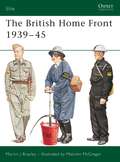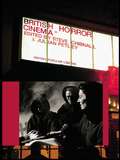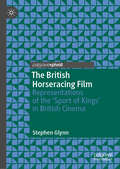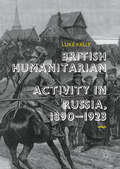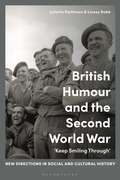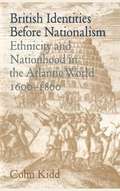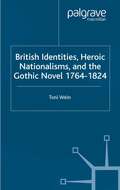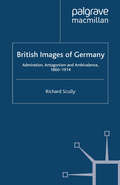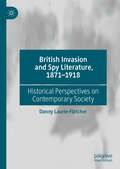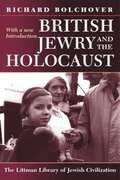- Table View
- List View
British Goats (Shire Library)
by Tiffany FrancisEver wondered why a goat's eyes have rectangular pupils? Or what happened to Thor's goats after they finished pulling his thunderous chariot? Is goat milk and meat a more ethical food choice, and if so, can these industries play an important role in the future of mankind? How about making your own goat's cheese or handspun mohair jumper? Whether you're an aspiring smallholder, cheese fanatic or simply want to know more about our caprine companions, this guide will take you through the fascinating history of goatkeeping in Britain and shed light on one of our most intelligent, curious and mischievous domestic animals. With an increasing demand for goat produce and around 16 different breeds in Britain, explore the cultural rise of goatkeeping from the Stone Age through to the modern day.
British Goats (Shire Library #864)
by Tiffany FrancisEver wondered why a goat's eyes have rectangular pupils? Or what happened to Thor's goats after they finished pulling his thunderous chariot? Is goat milk and meat a more ethical food choice, and if so, can these industries play an important role in the future of mankind? How about making your own goat's cheese or handspun mohair jumper? Whether you're an aspiring smallholder, cheese fanatic or simply want to know more about our caprine companions, this guide will take you through the fascinating history of goatkeeping in Britain and shed light on one of our most intelligent, curious and mischievous domestic animals. With an increasing demand for goat produce and around 16 different breeds in Britain, explore the cultural rise of goatkeeping from the Stone Age through to the modern day.
British Gothic Cinema (Palgrave Gothic)
by B. ForshawBarry Forshaw celebrates with enthusiasm the British horror film and its fascination for macabre cinema. A definitive study of the genre, British Gothic Cinema discusses the flowering of the field, with every key film discussed from its beginnings in the 1940s through to the 21st century.
British Historical Cinema (British Popular Cinema)
by Claire Monk Amy SargeantFilms recreating or addressing 'the past' - recent or distant, actual or imagined - have been a mainstay of British cinema since the silent era. From Elizabeth to Carry On Up The Khyber, and from the heritage-film debate to issues of authenticity and questions of genre, British Historical Cinema explores the ways in which British films have represented the past on screen, the issues they raise and the debates they have provoked. Discussing films from biopics to literary adaptations, and from depictions of Britain's colonial past to the re-imagining of recent decades in retro films such as Velvet Goldmine, a range of contributors ask whose history is being represented, from whose perspective, and why.
British Historical Cinema (British Popular Cinema)
by Claire Monk Amy SargeantFilms recreating or addressing 'the past' - recent or distant, actual or imagined - have been a mainstay of British cinema since the silent era. From Elizabeth to Carry On Up The Khyber, and from the heritage-film debate to issues of authenticity and questions of genre, British Historical Cinema explores the ways in which British films have represented the past on screen, the issues they raise and the debates they have provoked. Discussing films from biopics to literary adaptations, and from depictions of Britain's colonial past to the re-imagining of recent decades in retro films such as Velvet Goldmine, a range of contributors ask whose history is being represented, from whose perspective, and why.
The British Home Front 1939–45 (Elite)
by Martin Brayley Malcolm McGregorThe population of Britain was mobilized to support the war effort on a scale unseen in any other Western democracy – or in Nazi Germany. They endured long working shifts, shortages of food and all other goods, and complete government control of their daily lives. Most men and women were conscripted or volunteered for additional tasks outside their formal working hours. Under the air raids that destroyed the centres of many towns and made about 2 million homeless, more than 60,000 civilians were killed and 86,000 seriously injured. This fascinating illustrated summary of wartime life, and the organizations that served on the Home front, is a striking record of endurance and sacrifice.
The British Home Front 1939–45 (Elite #109)
by Martin Brayley Malcolm McGregorThe population of Britain was mobilized to support the war effort on a scale unseen in any other Western democracy – or in Nazi Germany. They endured long working shifts, shortages of food and all other goods, and complete government control of their daily lives. Most men and women were conscripted or volunteered for additional tasks outside their formal working hours. Under the air raids that destroyed the centres of many towns and made about 2 million homeless, more than 60,000 civilians were killed and 86,000 seriously injured. This fascinating illustrated summary of wartime life, and the organizations that served on the Home front, is a striking record of endurance and sacrifice.
British Horror Cinema (British Popular Cinema)
by Steve Chibnall Julian PetleyBritish Horror Cinema investigates a wealth of horror filmmaking in Britain, from early chillers like The Ghoul and Dark Eyes of London to acknowledged classics such as Peeping Tom and The Wicker Man. Contributors explore the contexts in which British horror films have been censored and classified, judged by their critics and consumed by their fans. Uncovering neglected modern classics like Deathline, and addressing issues such as the representation of family and women, they consider the Britishness of British horror and examine sub-genres such as the psycho-thriller and witchcraftmovies, the work of the Amicus studio, and key filmmakers including Peter Walker. Chapters include: the 'Psycho Thriller' the British censors and horror cinema femininity and horror film fandom witchcraft and the occult in British horror Horrific films and 1930s British Cinema Peter Walker and Gothic revisionism. Also featuring a comprehensive filmography and interviews with key directors Clive Barker and Doug Bradley, this is one resource film studies students should not be without.
British Horror Cinema (British Popular Cinema)
by Steve Chibnall Julian PetleyBritish Horror Cinema investigates a wealth of horror filmmaking in Britain, from early chillers like The Ghoul and Dark Eyes of London to acknowledged classics such as Peeping Tom and The Wicker Man. Contributors explore the contexts in which British horror films have been censored and classified, judged by their critics and consumed by their fans. Uncovering neglected modern classics like Deathline, and addressing issues such as the representation of family and women, they consider the Britishness of British horror and examine sub-genres such as the psycho-thriller and witchcraftmovies, the work of the Amicus studio, and key filmmakers including Peter Walker. Chapters include: the 'Psycho Thriller' the British censors and horror cinema femininity and horror film fandom witchcraft and the occult in British horror Horrific films and 1930s British Cinema Peter Walker and Gothic revisionism. Also featuring a comprehensive filmography and interviews with key directors Clive Barker and Doug Bradley, this is one resource film studies students should not be without.
The British Horseracing Film: Representations of the ‘Sport of Kings’ in British Cinema
by Stephen GlynnThis book constitutes the first full volume dedicated to an academic analysis of horseracing in British cinema. Through comprehensive contextual histories of film production and reception, together with detailed textual analysis, this book explores the aesthetic and emotive power of the enduringly popular horseracing genre, its ideologically-inflected landscape and the ways in which horse owners and riders, bookmakers and punters have been represented on British screen. The films discussed span from the 1890s to the present day and include silent shorts, quota quickies and big-budget biopics. A work of social and film history, The British Horseracing Film demonstrates how the so-called “sport of kings” functions as an accessible institutional structure through which to explore cinematic discussions about the British nation—but also, and equally, national approaches to British cinema.
British Humanitarian Activity in Russia, 1890-1923
by Luke KellyThis book analyses the efforts of British civil society to help a Russia seen to be struggling between 1890 and the 1920s. Luke Kelly seeks to show why churches, pressure groups, charities, politicians and journalists came to promote religious and political liberty and to relieve the victims of famines in late-tsarist and early communist Russia. By focusing on the roles of Christian, Jewish and liberal interests in deploying humanitarian solutions, Kelly shows how humanitarianism developed ‘from below’, while also examining the growth of a broader humanitarian discourse in the context of the Anglo-Russian relationship.
British Humanitarian Activity in Russia, 1890-1923
by Luke KellyThis book analyses the efforts of British civil society to help a Russia seen to be struggling between 1890 and the 1920s. Luke Kelly seeks to show why churches, pressure groups, charities, politicians and journalists came to promote religious and political liberty and to relieve the victims of famines in late-tsarist and early communist Russia. By focusing on the roles of Christian, Jewish and liberal interests in deploying humanitarian solutions, Kelly shows how humanitarianism developed ‘from below’, while also examining the growth of a broader humanitarian discourse in the context of the Anglo-Russian relationship.
British Humour and the Second World War: ‘Keep Smiling Through’ (New Directions in Social and Cultural History)
by Juliette Pattinson and Linsey RobbThis book skilfully combines cutting-edge historical research by leading and emerging researchers in the field to investigate the utilization of British humour during the Second World War as well as its legacy in British popular culture.Juliette Pattinson and Linsey Robb bring together case studies that address a variety of situations in which humour was generated, including wartime jokes, films, radio, cartoons and private drawings, as well as post-war recollections, museum exhibitions and television comedy. By adopting an original interpretative framework of various wartime and post-war sites, this books opens up the possibility for a more variegated, richer analysis of Britain's wartime experience and its place thereafter in the cultural imagination.Through the lens of humour, this book promises to add critical nuance to our understanding of the functioning of British wartime society. Covering sources such as The British Cartoon Archive, BBC World War II People's War Archive and The Ministry of Information, and including analysis of the lasting role of comedy in Britain's memories and depictions of the war, the result is a rich addition to existing literature of use to students and scholars studying the cultural history of war.
British Humour and the Second World War: ‘Keep Smiling Through’ (New Directions in Social and Cultural History)
This book skilfully combines cutting-edge historical research by leading and emerging researchers in the field to investigate the utilization of British humour during the Second World War as well as its legacy in British popular culture.Juliette Pattinson and Linsey Robb bring together case studies that address a variety of situations in which humour was generated, including wartime jokes, films, radio, cartoons and private drawings, as well as post-war recollections, museum exhibitions and television comedy. By adopting an original interpretative framework of various wartime and post-war sites, this books opens up the possibility for a more variegated, richer analysis of Britain's wartime experience and its place thereafter in the cultural imagination.Through the lens of humour, this book promises to add critical nuance to our understanding of the functioning of British wartime society. Covering sources such as The British Cartoon Archive, BBC World War II People's War Archive and The Ministry of Information, and including analysis of the lasting role of comedy in Britain's memories and depictions of the war, the result is a rich addition to existing literature of use to students and scholars studying the cultural history of war.
British Identities before Nationalism: Ethnicity and Nationhood in the Atlantic World, 1600–1800 (PDF)
by Colin KiddInspired by debates among political scientists over the strength and depth of the pre-modern roots of nationalism, this study attempts to gauge the status of ethnic identities in an era whose dominant loyalties and modes of political argument were confessional, institutional and juridical. Colin Kidd's point of departure is the widely shared orthodox belief that the whole world had been peopled by the offspring of Noah. In addition, Kidd probes inconsistencies in national myths of origin and ancient constitutional claims, and considers points of contact which existed in the early modern era between ethnic identities which are now viewed as antithetical, including those of Celts and Saxons. He also argues that Gothicism qualified the notorious Francophobia of eighteenth-century Britons. A wide-ranging example of the new British history, this study draws upon evidence from England, Scotland, Ireland and America, while remaining alert to European comparisons and influences.
British Identities, Heroic Nationalisms, and the Gothic Novel, 1764-1824
by T. WeinBritish Identities, Heroic Nationalisms, and the Gothic Novel, 1764-1824 considers three interlocking developments of this period: the emergence of the Gothic novel at a time when national upheavals required the construction of a new nationalist identity, the Gothic novel's redefinition of heroes and heroism in that nationalist debate, and changes within class and gender as well as audience and author relations. The scope of this study extends beyond the confines of the novel proper to include chapbooks and illustrated redactions.
British Images of Germany: Admiration, Antagonism & Ambivalence, 1860-1914 (Britain and the World)
by R. ScullyBritish Images of Germany is the first full-length cultural history of Britain's relationship with Germany in the key period leading up to the First World War. Richard Scully reassesses what is imagined to be a fraught relationship, illuminating the sense of kinship Britons felt for Germany even in times of diplomatic tension.
The British Immigration Courts: A study of law and politics
by Max TraversImmigration has been a controversial and contentious area of public policy since the Commonwealth Immigration Act ended most primary immigration in 1962. This study looks in detail at the work of practioners in the court-system that hears appeals from immigrants and asylum seekers against decisions made by the British Government. The book contains chapters about decision making in primary purpose and the asylum appeals, the administrative problems faced by successive British governments, and the perspectives of pressure groups and politicians. The British Immigration Courts transforms our understanding of immigration as a political issue through preserving a sense of routine work in the courts, civil service and political process which is ignored or idealised by other approaches. It is essential reading for practioners, academics and students interested in current debates about policy.
The British Impact on India (Routledge Revivals)
by Sir Percival GriffithsFirst published in 1952, imperialism is a regularly recurring historical phenomenon, calling for neither approval not condemnation in the abstract. A more profitable exercise is to consider particular imperialisms and assess their spirit and their achievements. From this premise Sir Percival Griffiths proceeds to examine the political, administrative and economic effects on India of British rule. Formerly a member of the Indian Civil Service, later the leader of the British representatives in the Indian Legislative Assembly and now closely connected with commerce and industry in India and Pakistan, he has the advantage of a three-sided approach. He was, moreover, playing an active part in Indian public affairs throughout the years leading to the transfer of power. In 1942 he declared that he would fight any government which resiled from the promise of independence for India and when the Cabinet Mission visited India in 1947, it fell on him to assert - on behalf of the British community in India – their conviction that independence must be granted without further delay. It is because he has thus been a close eye-witness of the events of the last three decades in India that he has written this book. Although Western civilization is often regarded by Indians as materialistic, it is the spiritual rather than in the material sphere that British influence has been greatest. It has built up Indian nationalism; it has engendered in Indian minds a new concept of equality and of human rights; it has rekindled the scientific spirit; and is has profoundly modified the Indian intellectual approach to the problems in life. In all this there have been losses as well as gain – not least among the losses being the partial destruction of village corporate life and the spread of specticism among the intelligentsia – but there can be little doubt which way the balance lies. A further fifty years may have to elapse, Sir Percival suggests, before a final assessment of the impact of the British is possible. In the meantime the present book may be confidently recommended as the most authoritative and objective examination of the history and influence of British administration in Indian, which has yet appeared; a book, furthermore, that may be expected to achieve the status of a standard work.
The British Impact on India (Routledge Revivals)
by Sir Percival GriffithsFirst published in 1952, imperialism is a regularly recurring historical phenomenon, calling for neither approval not condemnation in the abstract. A more profitable exercise is to consider particular imperialisms and assess their spirit and their achievements. From this premise Sir Percival Griffiths proceeds to examine the political, administrative and economic effects on India of British rule. Formerly a member of the Indian Civil Service, later the leader of the British representatives in the Indian Legislative Assembly and now closely connected with commerce and industry in India and Pakistan, he has the advantage of a three-sided approach. He was, moreover, playing an active part in Indian public affairs throughout the years leading to the transfer of power. In 1942 he declared that he would fight any government which resiled from the promise of independence for India and when the Cabinet Mission visited India in 1947, it fell on him to assert - on behalf of the British community in India – their conviction that independence must be granted without further delay. It is because he has thus been a close eye-witness of the events of the last three decades in India that he has written this book. Although Western civilization is often regarded by Indians as materialistic, it is the spiritual rather than in the material sphere that British influence has been greatest. It has built up Indian nationalism; it has engendered in Indian minds a new concept of equality and of human rights; it has rekindled the scientific spirit; and is has profoundly modified the Indian intellectual approach to the problems in life. In all this there have been losses as well as gain – not least among the losses being the partial destruction of village corporate life and the spread of specticism among the intelligentsia – but there can be little doubt which way the balance lies. A further fifty years may have to elapse, Sir Percival suggests, before a final assessment of the impact of the British is possible. In the meantime the present book may be confidently recommended as the most authoritative and objective examination of the history and influence of British administration in Indian, which has yet appeared; a book, furthermore, that may be expected to achieve the status of a standard work.
The British in France: Visitors and Residents since the Revolution
by Peter ThoroldCountless British visit France each year and over 100,000 live there permanently, successors to generations of their countrymen. This book, starting with the brief and poignant Peace of Amiens, 1801-1803, studies who they were - ranging from businessmen and artisans to rentiers, invalids and tourists - where they went and the reasons why. While some went for fun, to Paris 'where the social arts are carried to perfection' or to Monte Carlo, Biarritz or Deauville, the invalids favoured the Pyrenees or Savoy, making Pau the 'ville anglaise'. Bordeaux was an example of another town where the British attained great influence because of the wine trade. Many also settled in France to save money. The Channel Coast becoming popular with those who fled creditors or disgrace at home (Beau Brummell and Oscar Wilde are examples of this group). Food, architecture and the arts more generally attracted many, as did the climate of the Riviera.The revolutions in travel brought about by railways, motoring and aircraft provide a constant theme. Another very important aspect covered is the relationship, both in general and personal terms, between the French and the British. How, for instance, the local British stimulated a passion for sport in France. A variety of sources including British and French books, letters, journals and periodicals, supply background, as do Foreign Office archives particularly in times of crisis such as 1848, 1870 and 1940.
The British in India: Three Centuries of Ambition and Experience
by David GilmourThe British in this book lived in India from shortly a er the reign of Elizabeth I until well into the reign of Elizabeth II. Who were they? What drove these men and women to risk their lives on long voyages down the Atlantic and across the Indian Ocean or later via the Suez Canal? And when they got to India, what did they do and how did they live?This book explores the lives of the many different sorts of Briton who went to India: viceroys and offcials, soldiers and missionaries, planters and foresters, merchants, engineers, teachers anddoctors. It evokes the three and a half centuries of their ambitions and experiences, together with the lives of their families, recording the diversity of their work and their leisure, and the complexity of their relationships with the peoples of India. It also describes the lives of many whodid not t in with the usual image of the Raj: the tramps and rascals, the men who 'went native',the women who scorned the role of the traditional memsahib.David Gilmour has spent decades researching in archives, studying the papers of many people whohave never been written about before, to create a magni cent tapestry of British life in India. isexceptional work of scholarly recovery portrays individuals with understanding and humour, and makes an original and engaging contribution to a long and important period of British and Indian history.
British Invasion and Spy Literature, 1871–1918: Historical Perspectives on Contemporary Society
by Danny Laurie-FletcherThis book examines British invasion and spy literature and the political, social, and cultural attitudes that it expresses. This form of literature began to appear towards the end of the nineteenth century and developed into a clearly recognised form during the Edwardian period (1901-1914). By looking at the origins and evolution of invasion literature, and to a lesser extent detective literature, up to the end of World War I, Danny Laurie-Fletcher utilises fiction as a window into the mind-set of British society. There is a focus on the political arguments embedded within the texts, which mirrored debates in wider British society that took place before and during World War I – debates about military conscription, immigration, spy scares, the fear of British imperial decline, and the rise of Germany. These debates and topics are examined to show what influence they had on the creation of the intelligence services, MI5 and MI6, and how foreigners were perceived in society.
British Jewry and the Holocaust: With a New Introduction (The Littman Library of Jewish Civilization)
by Richard BolchoverHow did British Jewry respond to the Holocaust, how prominent was it on the communal agenda, and what does this response tell us about the values, politics, and fears of the Anglo-Jewish community? This book studies the priorities of that community, and thereby seeks to analyse the attitudes and philosophies which informed actions. It paints a picture of Anglo-Jewish life and its reactions to a wide range of matters in the non-Jewish world. Richard Bolchover charts the transmission of the news of the European catastrophe and discusses the various theories regarding reactions to these exceptional circumstances. He investigates the structures and political philosophies of Anglo-Jewry during the war years and covers the reactions of Jewish political and religious leaders as well as prominent Jews acting outside the community's institutional framework. Various co-ordinated responses, political and philanthropic, are studied, as are the issues which dominated the community at that time, namely internal conflict and the fear of increased domestic antisemitism: these preoccupations inevitably affected responses to events in Europe. The latter half of the book looks at the ramifications of the community's socio-political philosophies including, most radically, Zionism, and their influence on communal reactions. This acclaimed study raises major questions about the structures and priorities of the British Jewish community. For this paperback, the author has added a new Introduction summarizing research in the field since the book's first appearance.
The British Labour Movement and Zionism, 1917-1948
by Joseph GornyFirst Published in 1983. Routledge is an imprint of Taylor & Francis, an informa company.




